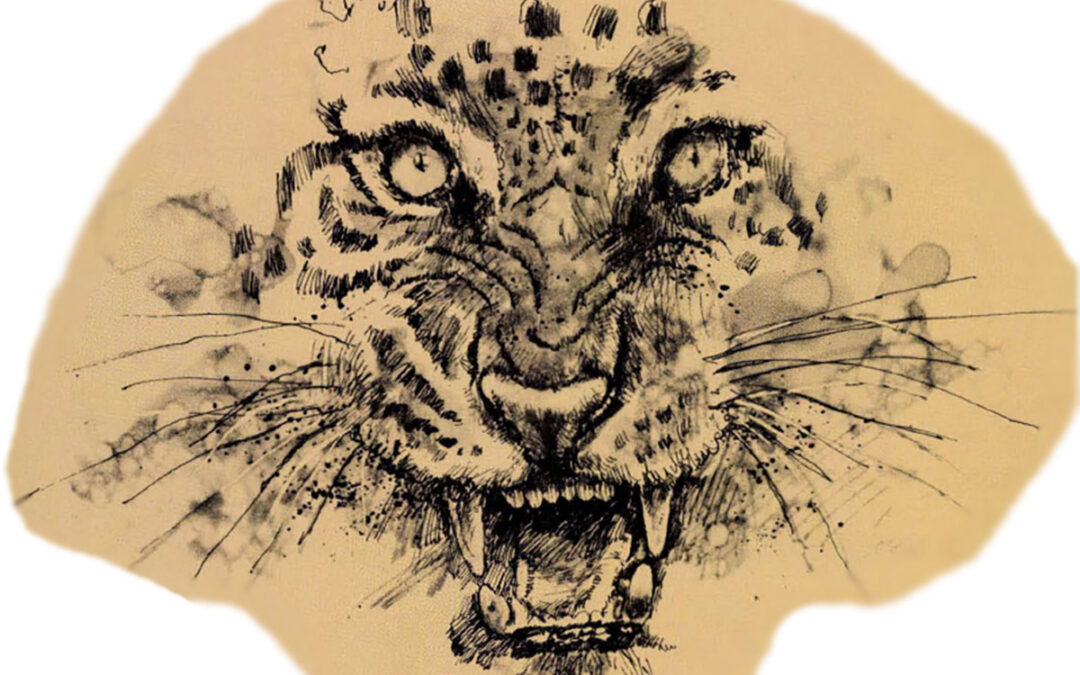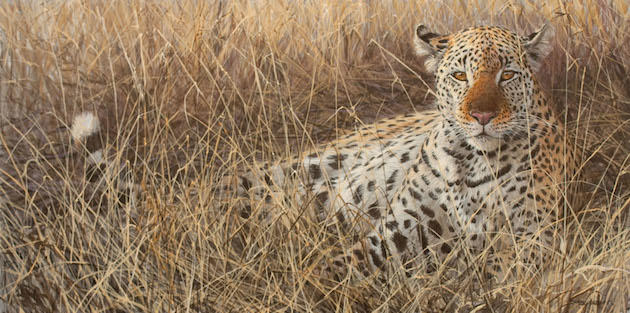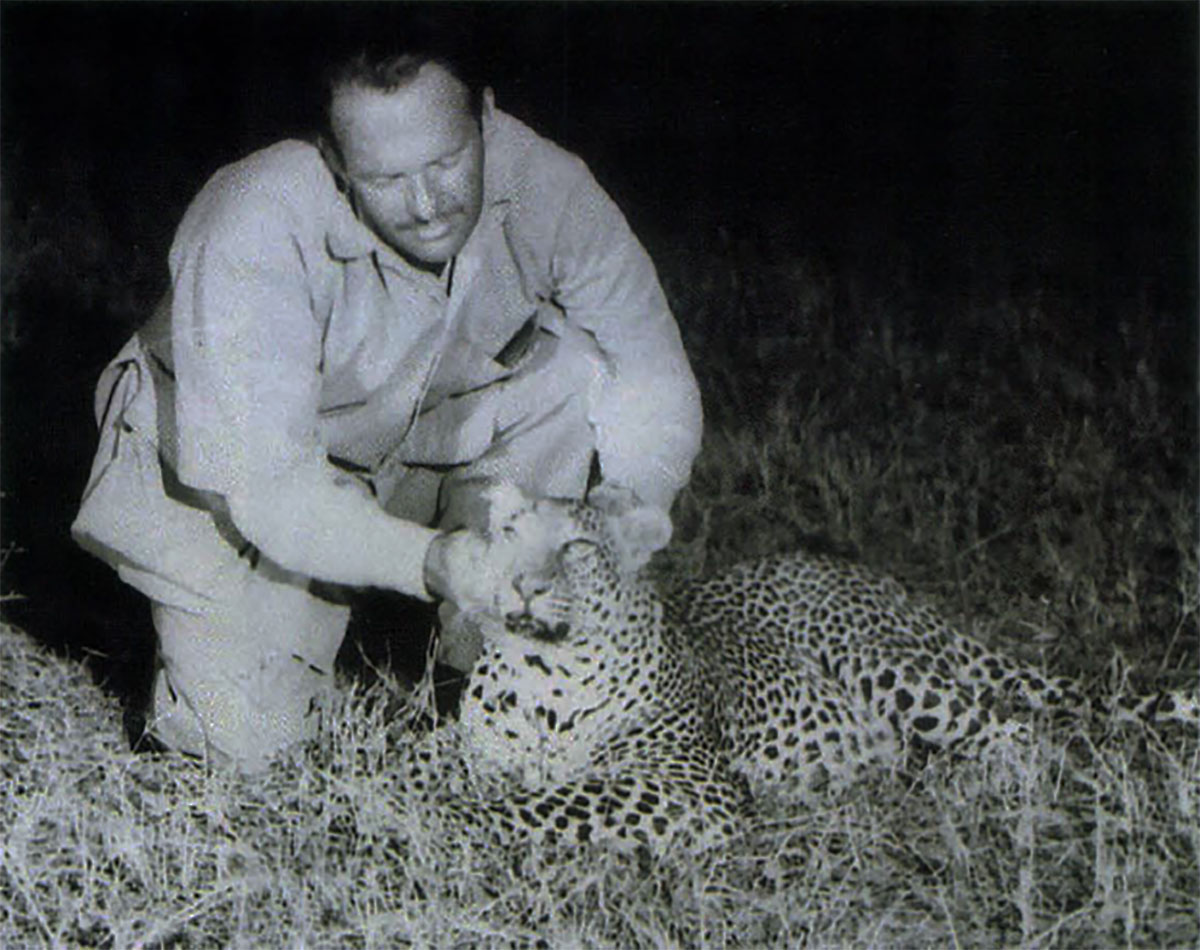Kenneth Douglas Stuart Anderson (1910-1974) was an Anglo-Indian who spent most of his life in Bangalore, India. An avid hunter, he was fascinated by the subcontinent’s big cats, and most of his tales dealt with the drama and dangers of man-killing tigers and panthers. This story is from his book, Nine Man-Eaters and One Rogue.
The leopard is common to practically all tropical jungles, and unlike the tiger, indigenous to the forests of India; for whereas it has been established that the tiger is a comparatively recent newcomer from regions in the colder north, records and remains have shown that the leopard — or panther, as it is better known in India — has lived in the peninsula from the earliest times.
Because of its smaller size, and decidedly lesser strength, together with its innate fear of mankind, the panther is often treated with some derision, sometimes coupled with truly astonishing carelessness, two factors that have resulted in the maulings and occasional deaths of otherwise intrepid but cautious tiger-hunters. Even when attacking a human being the panther rarely kills, but confines itself to a series of quick bites and quicker raking scratches with its small but sharp claws; on the other hand, few persons live to tell that they have been attacked by a tiger.
This general rule has one fearful exception, however, and that is the panther that has turned man-eater. Although examples of such animals are comparatively rare, when they do occur they depict the panther as an engine of destruction quite equal to his far larger cousin, the tiger. Because of his smaller size he can conceal himself in places impossible to a tiger, his need for water is far less, and in veritable demoniac cunning and daring, coupled with the uncanny sense of self-preservation and stealthy disappearance when danger threatens, he has no equal.
Such an animal was the man-eating leopard of Gummalapur. This leopard had established a record of some 42 human killings and a reputation for veritable cunning that almost exceeded human intelligence. Some fearful stories of diabolical craftiness had been attributed to him, but certain it was that the panther was held in awe throughout an area of some 250 square miles over which it held undisputable sway.
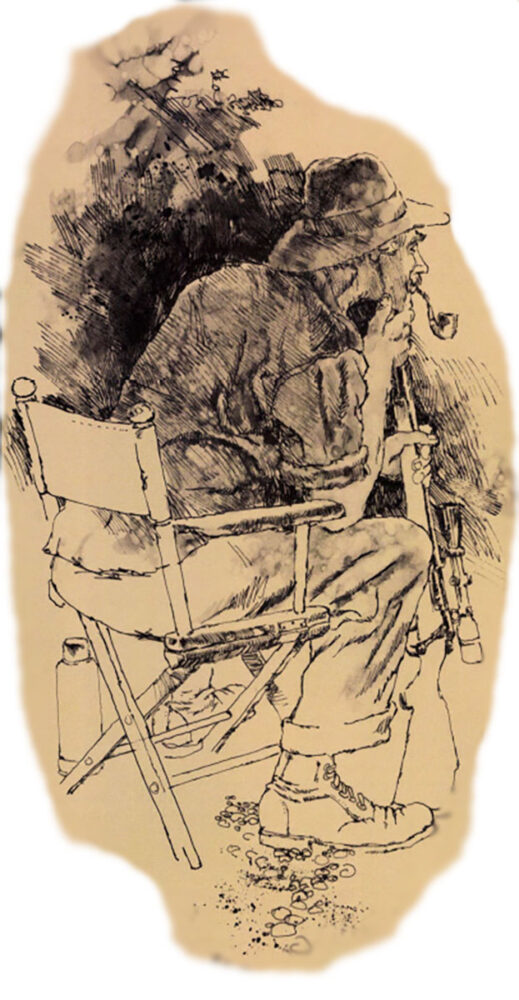 Before sundown the door of each hut in every one of the villages within this area was fastened shut, some being reinforced by piles of boxes or large stones, kept for the purpose. Not until the sun was well up in the heavens next morning did the timid inhabitants venture to expose themselves. This state of affairs rapidly told on the sanitary condition of the houses, the majority of which were not equipped with latrines of any sort, the adjacent waste land being used for the purpose.
Before sundown the door of each hut in every one of the villages within this area was fastened shut, some being reinforced by piles of boxes or large stones, kept for the purpose. Not until the sun was well up in the heavens next morning did the timid inhabitants venture to expose themselves. This state of affairs rapidly told on the sanitary condition of the houses, the majority of which were not equipped with latrines of any sort, the adjacent waste land being used for the purpose.
Finding that its human meals were increasingly difficult to obtain, the panther became correspondingly bolder, and in two instances burrowed its way in through the thatched walls of the smaller huts, dragging its screaming victim out the same way, while the whole village lay awake, trembling behind closed doors, listening to the shrieks of the victim as he was carried away. In one case the panther, frustrated from burrowing its way in through the walls, which had been boarded up with rough planks, resorted to the novel method of entering through the thatched roof. In this instance it found itself unable to carry its prey back through the hole it had made, so in a paroxysm of fury had killed all four inhabitants of the hut —a man, his wife and two children — before clawing its way back to the darkness outside and to safety.
Only during the day did the villagers enjoy any respite. Even then they moved about in large, armed groups, but so far no instance had occurred of the leopard attacking in daylight, although it had been very frequently seen at dawn within the precincts of a village.
Such was the position when I arrived at Gummalapur, in response to an invitation from Jepson, the District Magistrate, to rid his area of this scourge. Preliminary conversation with some of the inhabitants revealed that they appeared dejected beyond hope, and with true eastern fatalism had decided to resign themselves to the fact that this shaitan, from whom they believed deliverance to be impossible, had come to stay, till each one of them had been devoured or had fled the district as the only alternative.
It was soon apparent that I would get little or no cooperation from the villagers, many of whom openly stated that if they dared to assist me the shaitan would come to hear of it and would hasten their end. Indeed, they spoke in whispers as if afraid that loud talking would be overheard by the panther, who would single them out for revenge.
That night, I sat in a chair in the midst of the village, with my back to the only house that possessed a 12-foot wall, having taken the precaution to cover the roof with a deep layer of thorns and brambles, in case I should be attacked from behind by the leopard leaping down on me. It was a moonless night, but the clear sky promised to provide sufficient illumination from its myriad stars to enable me to see the panther should it approach.
The evening, at six o’clock, found the inhabitants behind locked doors, while I sat alone on my chair, with my rifle across my lap, loaded and cocked, a flask of hot tea nearby, a blanket, a water bottle, some biscuits, a torch at hand and of course my pipe, tobacco and matches as my only consolation during the long vigil till daylight returned.
With the going down of the sun a period of acute anxiety began, for the stars were as yet not brilliant enough to light the scene even dimly. Moreover, immediately to westward of the village lay two abrupt hills which hastened the dusky uncertainty that might otherwise have been lessened by some reflection from the recently set sun.
I gripped my rifle and stared around me, my eyes darting in all directions and from end to end of the deserted village street. At that moment I would have welcomed the jungle, whereby their cries of alarm I could rely on the animals and birds to warn me of the approach of the panther. Here all was deathly silent, and the whole village might have been entirely deserted, for not a sound escaped from the many inhabitants whom I knew lay listening behind closed doors, and listening for the scream that would herald my death and another victim for the panther.
Time passed, and one by one the stars became visible, till, by 7: 15pm, they shed a sufficiently diffused glow to enable me to see along the whole village street, although somewhat indistinctly. My confidence returned, and I began to think of some way to draw the leopard towards me, should he be in the vicinity. I forced myself to cough loudly at intervals and then began to talk to myself, hoping that my voice would be heard by the panther and bring him to me quickly.
I do not know if any of my readers have ever tried talking to themselves loudly for any reason, whether to attract a man-eating leopard or not. I suppose there must be a few, for I realize what reputation the man who talks to himself acquires. I am sure I acquired that reputation with the villagers, who from behind their closed doors listened to me that night as I talked to myself. But believe me, it is no easy task to talk loudly to yourself for hours on end, while watching intently for the stealthy approach of a killer.
By 9pm, I got tired of it, and considered taking a walk around the streets of the village. After some deliberation I did this, still talking to myself as I moved cautiously up one lane and down the next, frequently glancing back over my shoulder. I soon realized, however, that I was exposing myself to extreme danger, as the panther might pounce on me from any corner, from behind any pile of garbage, or from the roof tops of any of the huts. Ceasing my talking abruptly, I returned to my chair, thankful to get back alive.
Time dragged by very slowly and monotonously, the hours seeming to pass on leaden wheels. Midnight came and I found myself feeling cold, due to a sharp breeze that had set in from the direction of the adjacent forest, which began beyond the two hillocks. I drew the blanket closely around me, while consuming tobacco far in excess of what was good for me. By 2am, I found I was growing sleepy. Hot tea and some biscuits, followed by icy water from the bottle dashed into my face and a quick raising and lowering of my body from the chair half-a-dozen times, revived me a little and I fell to talking to myself again, as a means of keeping awake thereafter.
At 3:30am, came an event which caused me untold discomfort for the next two hours. With the sharp wind banks of heavy cloud were carried along, and these soon covered the heavens and obscured the stars, making the darkness intense, and it would have been quite impossible to see the panther a yard away. I had undoubtedly placed myself in an awkward position, and entirely at the mercy of the beast, should it choose to attack me now. I fell to flashing my torch every half-minute from end to end of the street, a proceeding which was very necessary if I hoped to remain alive with the panther anywhere near, although I felt I was ruining my chances of shooting the beast, as the bright torch-beams would probably scare it away. Still, there was the possibility that it might not be frightened by the light, and that I might be able to see it and bring off a lucky shot, a circumstance that did not materialize, as morning found me still shining the torch after a night-long and futile vigil.
I snatched a few hours’ sleep and at noon fell to questioning the villagers again. Having found me still alive that morning — quite obviously contrary to their expectations — and possibly crediting me with the power to communicate with spirits because they had heard me walking around their village talking, they were considerably more communicative and gave me a few more particulars about the beast. Apparently, the leopard wandered about its domain a great deal, killing erratically and at places widely distant from one another, and as I had already found out, never in succession at the same village. As no human had been killed at Gummalapur within the past three weeks, it seemed that there was much to be said in favor of staying where I was, rather than moving around, in a haphazard fashion, hoping to come up with the panther. Another factor against wandering about was that this beast was rarely visible in the daytime, and there was therefore practically no chance of my meeting it, as might have been the case with a man-eating tiger. It was reported that the animal had been wounded in its right fore-foot, since it had the habit of placing the pad sidewards, a fact which I was later able to confirm when I actually came across the tracks of the animal.
After lunch, I conceived a fresh plan for that night, which would certainly save me from the great personal discomforts I had experienced the night before. This was to leave a door of one of the huts ajar, and to rig up inside it a very life-like dummy of a human being; meanwhile, I would remain in a corner of the same hut behind a barricade of boxes. This would provide an opportunity to slay the beast as he became visible in the partially opened doorway, or even as he attacked the dummy, while I myself would be comparatively safe and warm behind my barricade.
I explained the plan to the villagers, who, to my surprise, entered into it with some enthusiasm. A hut was placed at my disposal immediately next to that through the roof of which the leopard had once entered and killed the four inmates. A very life-like dummy was rigged up, made of straw, an old pillow, a jacket and a saree. This was placed within the doorway of the hut in a sitting position, the door itself being kept half-open. I sat myself behind a low parapet of boxes, placed diagonally across the opposite end of the small hut, the floor of which measured about 12 feet by 10 feet. At this short range, I was confident of accounting for the panther as soon as it made itself visible in the doorway. Furthermore, should it attempt to enter by the roof, or through the thatched walls, I would have ample time to deal with it. To make matters even more realistic, I instructed the inhabitants of both the adjacent huts, especially the women folk, to endeavor to talk in low tones as far into the night as was possible, in order to attract the killer to that vicinity.
An objection was immediately raised, that the leopard might be led to enter one of their huts, instead of attacking the dummy in the doorway of the hut in which I was sitting. This fear was only overcome by promising to come to their aid should they hear the animal attempting an entry. The signal was to be a normal call for help, with which experience had shown the panther to be perfectly familiar, and of which he took no notice. This plan also assured me that the inhabitants would themselves keep awake and continue their low conversation in snatches, in accordance with my instructions.
Everything was in position by 6pm, at which time all doors in the village were secured, except that of the hut where I sat. The usual uncertain dusk was followed by bright starlight that threw the open doorway and the crouched figure of the draped dummy into clear relief. Now and again I could hear the low hum of conversation from the two neighboring huts.
The hours dragged by in dreadful monotony. Suddenly the silence was disturbed by a rustle in the thatched roof which brought me to full alertness. But it was only a rat, which scampered across and then dropped with a thud to the floor nearby, from where it ran along the tops of the boxes before me, becoming clearly visible as it passed across the comparatively light patch of the open doorway. As the early hours of the morning approached, I noticed that the conversation from my neighbors died down and finally ceased, showing that they had fallen asleep, regardless of man-eating panther, or anything else that might threaten them.
I kept awake, occasionally smoking my pipe, or sipping hot tea from the flask, but nothing happened beyond the noises made by the tireless rats, which chased each other about and around the room, and even across me, till daylight finally dawned, and I lay back to fall asleep after another tiring vigil.
The following night, for want of a better plan, and feeling that sooner or later the man-eater would appear, I decided to repeat the performance with the dummy, and I met with an adventure which will remain indelibly impressed on my memory till my dying day.
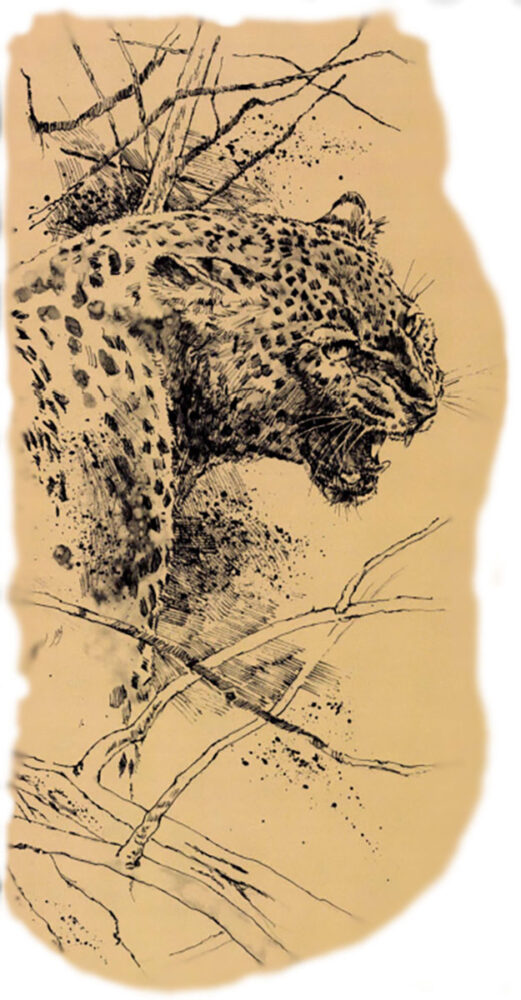 I was in position again by six o’clock, and the first plan of the night was but a repetition of the night before. The usual noise of scurrying rats, broken now and again by the low-voiced speakers in the neighboring huts, were the only sounds to mar the stillness of the night. Shortly after 1am, a sharp wind sprang up, and I could hear the breeze rustling through the thatched roof. This rapidly increased in strength, till it was blowing quite a gale. The rectangular patch of light from the partly open doorway practically disappeared as the sky became overcast with storm clouds, and soon the steady rhythmic patter of raindrops, which increased to a regular downpour, made me feel that the leopard, who like all his family are not over-fond of water, would not venture out on this stormy night, and that I would draw a blank once more.
I was in position again by six o’clock, and the first plan of the night was but a repetition of the night before. The usual noise of scurrying rats, broken now and again by the low-voiced speakers in the neighboring huts, were the only sounds to mar the stillness of the night. Shortly after 1am, a sharp wind sprang up, and I could hear the breeze rustling through the thatched roof. This rapidly increased in strength, till it was blowing quite a gale. The rectangular patch of light from the partly open doorway practically disappeared as the sky became overcast with storm clouds, and soon the steady rhythmic patter of raindrops, which increased to a regular downpour, made me feel that the leopard, who like all his family are not over-fond of water, would not venture out on this stormy night, and that I would draw a blank once more.
By now the murmuring voices from then neighboring huts had ceased or become inaudible, drowned in the swish of the rain. I strained my eyes to see the scarcely perceptible doorway, while the crouched figure of the dummy could not be seen at all, and while I looked I evidently fell asleep, tired out by my vigil of the two previous nights.
How long I slept I cannot tell but it must have been for some considerable time. I awoke abruptly with a start, and a feeling that all was not well. The ordinary person in awaking takes some time to collect his faculties, but my-jungle training and long years spent in dangerous places enabled me to remember where I was and in what circumstances, as soon as I awoke.
The rain had ceased and the sky had cleared a little, for the oblong patch of open doorway was more visible now, with the crouched figure of the dummy seated as its base. Then, as I watched, a strange thing happened. The dummy seemed to move, and as I looked more intently it suddenly disappeared to the accompaniment of a snarling growl. I realized that the panther had come, seen the crouched figure of the dummy in the doorway which it had mistaken for a human being and then proceeded to stalk it, creeping in at the opening on its belly, and so low to the ground that its form had not been outlined in the faint light as I had hoped. The growl I had heard was at the panther’s realization that the thing it had attacked was not human after all.
Switching on my torch and springing to my feet, I hurdled the barricade of boxes and sprang to the open doorway, to dash outside and almost trip over the dummy which lay across my path. I shone the beam of torchlight in both directions, but nothing could be seen. Hoping that the panther might still be lurking nearby and shining my torch beam into every corner, I walked slowly down the village street, cautiously negotiated the bend at its end and walked back up the next street, in fear and trembling of a sudden attack. But although the light lit up every corner, every roof-top and every likely hiding place in the street, there was no sign of my enemy anywhere. Then only did I realize the true significance of the reputation this animal had acquired of possessing diabolical cunning. Just as my own sixth sense had wakened me from sleep at a time of danger, a similar sixth sense had warned the leopard that here was no ordinary human being, but one that was bent upon its destruction. Perhaps it was the bright beam of torchlight that had unnerved it at the last moment; but, whatever the cause, the man-eater had silently, completely and effectively disappeared, for although I searched for it through all the streets of Gummalapur that night, it had vanished as mysteriously as it had come.
Disappointment, and annoyance with myself at having fallen asleep, were overcome with a grim determination to get even with this beast at any cost.
Next morning the tracks of the leopard were clearly visible at the spot it had entered the village and crossed a muddy drain, where for the first time I saw the pugmarks of the slayer and the peculiar indentation of its right forefoot, the paw of which was not visible as a pugmark, but remained a blur, due to this animal’s habit of placing it on edge. Thus it was clear to me that the panther had at some time received an injury to its foot which had turned it into a man-eater. Later I was able to view the injured foot for myself, and I was probably wrong in my deductions as to the cause of its man-eating propensities; for I came to learn that the animal had acquired the habit of eating the corpses which the people of that area, after a cholera epidemic within the last year, had by custom carried into the forest and left to the vultures. These easily procured meals had given the panther a taste for human flesh, and the injury to its foot, which made normal hunting and swift movement difficult, had been the concluding factor in turning it into that worst of all menaces to an Indian village —a man-eating panther.
I also realized that, granting the panther was equipped with an almost-human power of deduction, it would not appear in Gummalapur again for a long time after the fright I had given it the night before in following it with my torch light.
It was therefore obvious that I would have to change my scene of operations, and so, after considerable thought, I decided to move on to the village of Devarabetta, diagonally across an intervening range of forest hills, and some 18 miles away, where the panther had already secured five victims, though it had not been visited for a month.
Therefore, I set out before 11am, that very day, after an early lunch. The going was difficult, as the path led across two hills. Along the valley that lay between them ran a small jungle stream, and beside it I noted the fresh pugs of a big male tiger that had followed the watercourse for some 200 yards before crossing to the other side. It had evidently passed early that morning, as was apparent from the minute trickles of moisture that had seeped into the pugmarks through the river sand, but had not had time to evaporate in the morning sun. Holding steadfastly to the job in hand, however, I did not follow the tiger and arrived at Devarabetta just after 5pm.
The inhabitants were preparing to shut themselves into their huts when I appeared, and scarcely had the time nor inclination to talk to me. However, I gathered that they agreed that a visit from the man-eater was likely any day, for a full month had elapsed since his last visit and he had never been known to stay away for so long.
Time being short, I hastily looked around for the hut with the highest wall, before which I seated myself as on my first night at Gummalapur, having hastily arranged some dried thorny bushes across its roof as protection against attack from my rear and above. These thorns had been brought from the hedge of a field bordering the village itself, and I had had to escort the men who carried them with my rifle, so afraid they were of the man-eater’s early appearance.
Devarabetta was a far smaller village than Gummalapur, and situated much closer to the forest, a fact which I welcomed for the reason that I would be able to obtain information as to the movements of carnivora by the warning notes that the beasts and birds of the jungle would utter, provided I was within hearing.
The night fell with surprising rapidity, though this time a thin sickle of new-moon was showing in the sky. The occasional call of a roosting jungle cock, and the plaintive call of peafowl, answering one another from the nearby forest, told me that all was still well. And then it was night, the faint starlight rendering hardly visible, and as if in a dream, the tortuously winding and filthy lane that formed the main street of Devarabetta. At 8:30pm, a sambar hind belled from the forest, following her original short note with a series of warning cries in steady succession. Undoubtedly a beast of prey was afoot and had been seen by the watchful deer, who was telling the other jungle-folk to look out for their lives. Was it the panther or one of the larger carnivora? Time alone would tell, but at least I had been warned.
The hind ceased her belling, and some 15 minutes later, from the direction in which she had first sounded her alarm, I heard the low moan of a tiger, to be repeated twice in succession, before all became silent again. It was not a mating call that I had heard, but the call of the King of the Jungle in his normal search for food, reminding the inhabitants of the forest that their master was on the move in search of prey and that one of them must die that night to appease his voracious appetite.
Time passed, and then down the lane I caught sight of some movement. Raising my cocked rifle, I covered the object, which slowly approached me, walking in the middle of the street. Was this the panther after all, and would it walk this openly, and in the middle of the lane, without any attempt at concealment? It was now about 30 yards away and still it came on boldly, without any attempt to take cover or to creep along the edges of objects in the usual manner of a leopard when stalking its prey. Moreover, it seemed a frail and slender animal, as I could see it fairly clearly now. Twenty yards and I pressed the button of my torch, which this night I had clamped to my rifle.
As the powerful beam threw across the intervening space it lighted a village cur, commonly known to us in India as a ‘pariah’ dog. Starving and lonely, it had sought out human company; it stared blankly into the bright beam of light, feebly wagging a skinny tail in unmistakable signs of friendliness.
Welcoming a companion, if only a lonely cur, I switched off the light and called it to my side by a series of flicks of thumb and finger. It approached cringingly, still wagging its ridiculous tail. I fed it some biscuits and a sandwich, and in the dull light of the star-lit sky its eyes looked back at me in dumb gratitude for the little food I had given it, perhaps the first to enter its stomach for the past two days. Then it curled up at my feet and fell asleep.
Time passed and midnight came. A great horned owl hooted dismally from the edge of the forest, its prolonged mysterious cry of ‘Whooo-whooo’ seeming to sound a death-knell, or a precursor to that haunting part of the night when the souls of those not at rest return to the scenes of their earthly activities, to live over and over again the deeds that bind them to the earth.
One o’clock, two and then three o’clock passed in dragging monotony, while I strained my tired and aching eyes and ears for movement or sound. Fortunately it had remained a cloudless night and visibility was comparatively good by the radiance of the myriad starts that spangled the heavens in glorious array, a sight that cannot be seen in any of our dusty towns or cities.
And then, abruptly, the alarmed cry of a plover, or ‘Did-you-do-it’ bird, as it is known in India, sounded from the nearby muddy tank on the immediate outskirts of the village. ‘Did-you-do-it, Did-you-do-it, Did-you-do-it, Did-you-doit’, it called in rapid regularity. No doubt the bird was excited and had been disturbed, or it had seen something. The cur at my feet stirred, raised its head, then sank down again, as if without a care in the world.
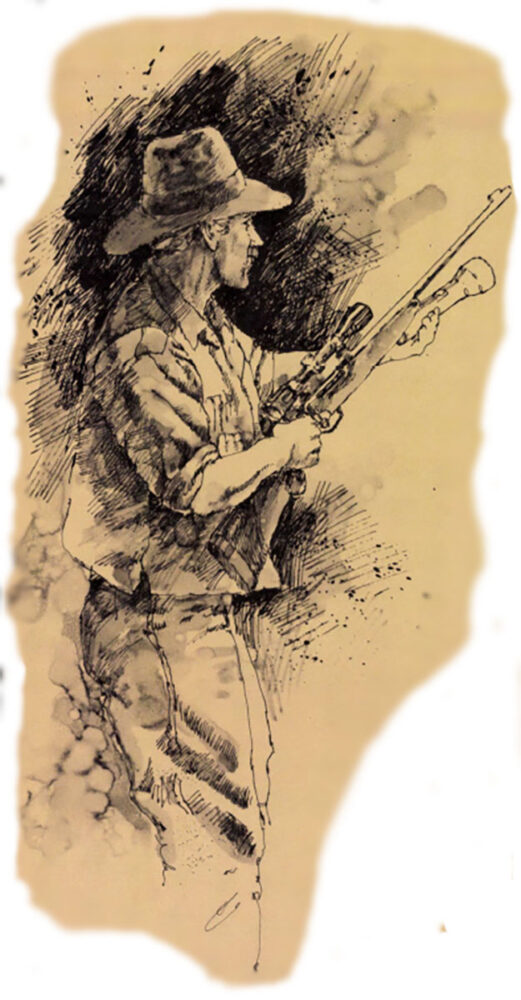 The minutes passed, and then suddenly the dog became fully awake. Its ears, that had been drooping in dejection, were standing on end, it trembled violently against my legs, while a low prolonged growl came from its throat. I noticed that it was looking down the lane that led into the village from the vicinity of the tank.
The minutes passed, and then suddenly the dog became fully awake. Its ears, that had been drooping in dejection, were standing on end, it trembled violently against my legs, while a low prolonged growl came from its throat. I noticed that it was looking down the lane that led into the village from the vicinity of the tank.
I stared intently in that direction. For a long time, I could see nothing, and then it seemed that a shadow moved at a comer of a building some distance away and on the same side of the lane. I focused my eyes on this spot, and after a few seconds again noticed a furtive movement, but this time a little closer.
Placing my left thumb on the switch which would actuate the torch, I waited in the breathless silence. A few minutes passed, five or ten at the most, and then I saw an elongated body spring swiftly and noiselessly on to the roof of a hut some 20 yards away. As it happened, all the huts adjoined each other at this spot and I guessed the panther had decided to walk along the roofs of these adjoining huts and spring upon me from the rear, rather than continue stalking me in full view.
I got to my feet quickly and placed my back against the wall. In this position the eave of the roof above my head passed over me and on to the road where I had been sitting, for about 18 inches. The rifle I kept ready, finger on trigger, with my left thumb on the torch switch, pressed to my side and pointing upwards.
A few seconds later, I heard a faint rustling as the leopard endeavored to negotiate the thorns which I had taken the precaution of placing on the roof. He evidently failed in this, for there was silence again. Now I had no means of knowing where he was. The next 15 minutes passed in terrible anxiety, with me glancing in all directions in the attempt to locate the leopard before he sprang, while thanking Providence that the night remained clear. And then the cur, that had been restless and whining at my feet, shot out into the middle of the street, faced the corner of the hut against which I was sheltering and began to bark lustily.
This warning saved my life, for within five seconds the panther charged around the corner and sprang at me. I had just time to press the torch switch and fire from my hip, full into the blazing eyes that showed above the wide-opened, snarling mouth. The .405 bullet struck squarely, but the impetus of the charge carried the animal on to me. I jumped nimbly to one side, and as the panther crashed against the wall of the hut, emptied two more rounds from the magazine into the evil, spotted body.
It collapsed and was still, except for the spasmodic jerking of the still-opened jaws and long, extended tail. And then my friend the cur, staunch in faithfulness to his new-found master, rushed in and fixed his feeble teeth int he throat of the dead monster.
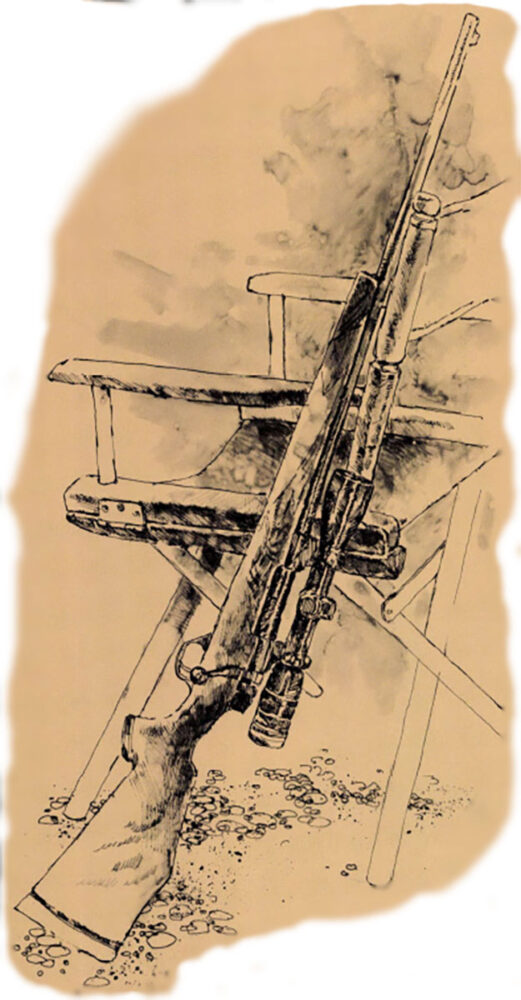 And so passed the ‘Spotted DeviI of Gummalapur’, a panther of whose malignant craftiness I had never heard the like before and hope never to have to meet again.
And so passed the ‘Spotted DeviI of Gummalapur’, a panther of whose malignant craftiness I had never heard the like before and hope never to have to meet again.
When skinning the animal next morning, I found that the injury to the right paw had not been caused, as I had surmised, by a previous bullet wound, but by two porcupine quills that had penetrated between the toes within an inch of each other and then broken off short. This must have happened quite a while before, as a gristly formation between the bones inside the foot had covered the quills. No doubt it had hurt the animal to place his paw on the ground in the normal way, and he had acquired the habit of walking on its edge.
I took the cur home, washed and fed it, and named it ‘Nipper’. Nipper has been with me many years since then, and never have I had reason to regret giving him the few biscuits and sandwich that won his staunch little heart and caused him to repay that small debt within a couple of hours, by saving my life.
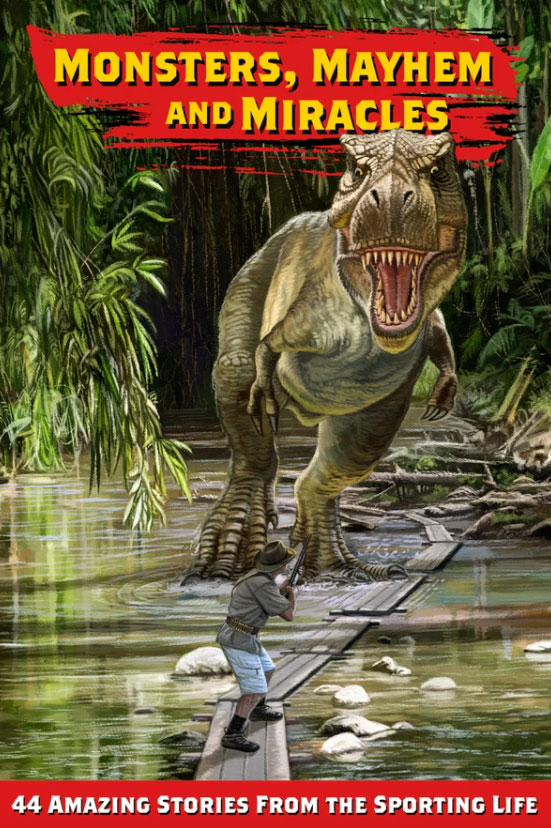 Truly a first in the world of outdoor publishing, Monsters, Mayhem and Miracles is a one-of-a-kind collection of unforgettable tales from the sporting world. Its 44 stories range from harrowing encounters with deadly predators to astonishing tales involving spirits, ghosts and even the devil himself.
Truly a first in the world of outdoor publishing, Monsters, Mayhem and Miracles is a one-of-a-kind collection of unforgettable tales from the sporting world. Its 44 stories range from harrowing encounters with deadly predators to astonishing tales involving spirits, ghosts and even the devil himself.
Featuring both fictional and true-to-life adventures, these astonishing stories are from the creative minds of such legendary authors as Peter Capstick, Archibald Rutledge, Gene Hill, Mike Gaddis, Roger Pinckney and John Madson.
On these 354 pages, you’ll also find hilarious predicaments, stunning feats of bravery and dramatic rescues as hunters and anglers are caught up in deadly encounters with everything from bears, moose and man-eating lions to sharks and crocodiles. Altogether, you’ll not find a more endearing and absorbing collection of wild and wacky stories. Buy Now

